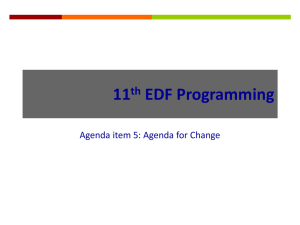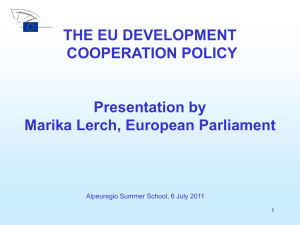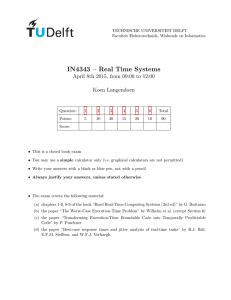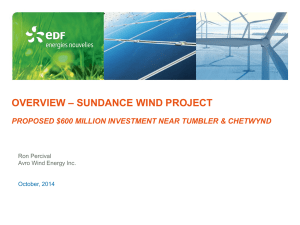Read the EDF 11 Analysis
advertisement
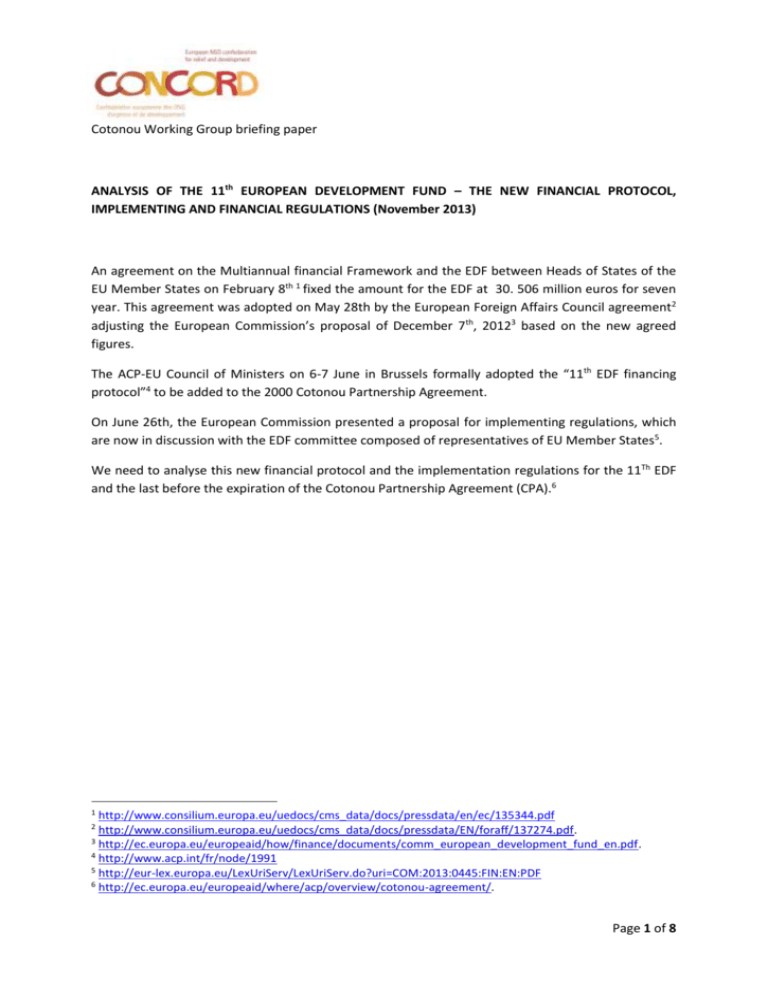
Cotonou Working Group briefing paper ANALYSIS OF THE 11th EUROPEAN DEVELOPMENT FUND – THE NEW FINANCIAL PROTOCOL, IMPLEMENTING AND FINANCIAL REGULATIONS (November 2013) An agreement on the Multiannual financial Framework and the EDF between Heads of States of the EU Member States on February 8th 1 fixed the amount for the EDF at 30. 506 million euros for seven year. This agreement was adopted on May 28th by the European Foreign Affairs Council agreement2 adjusting the European Commission’s proposal of December 7th, 20123 based on the new agreed figures. The ACP-EU Council of Ministers on 6-7 June in Brussels formally adopted the “11th EDF financing protocol”4 to be added to the 2000 Cotonou Partnership Agreement. On June 26th, the European Commission presented a proposal for implementing regulations, which are now in discussion with the EDF committee composed of representatives of EU Member States5. We need to analyse this new financial protocol and the implementation regulations for the 11Th EDF and the last before the expiration of the Cotonou Partnership Agreement (CPA).6 1 http://www.consilium.europa.eu/uedocs/cms_data/docs/pressdata/en/ec/135344.pdf http://www.consilium.europa.eu/uedocs/cms_data/docs/pressdata/EN/foraff/137274.pdf. 3 http://ec.europa.eu/europeaid/how/finance/documents/comm_european_development_fund_en.pdf. 4 http://www.acp.int/fr/node/1991 5 http://eur-lex.europa.eu/LexUriServ/LexUriServ.do?uri=COM:2013:0445:FIN:EN:PDF 6 http://ec.europa.eu/europeaid/where/acp/overview/cotonou-agreement/. 2 Page 1 of 8 Cotonou Working Group briefing paper Financial protocol In billion euros Total EDF – ACP and OCTs and Support Exp.7 (current prices) Total EDF ACP only (current prices) 10th EDF 11th EDF € 22.682 € 21.966 EC proposal Council agreement € 34. 276 € 30.506 100% € 32.218 100% € 29.089 100% Geographic funds (bilateral and regional cooperation)) € 17.766 80,88% of ACP part € 27.658 85,85% € 24.365 83,76% of ACP part Intra –ACP funds (thematic projects) € 2.700 12,29% of ACP part € 3.960 12,29% € 3.590 12,34% of ACP part Investment Facility € 1.500 6,83% of ACP part € 600 1,86% € 1.134 3,90% of ACP part Support Expenditure 8 € 430 2% of total EDF € 1.713 5% of total EDF € 1.052 3,45% of total EDF European Investment Bank (EIB)9 €2 € 2.5 € 2.5 (additional to EDF) 7 Support expenditures EIB excluded EUR 1 052,5 million shall be allocated to the Commission for support expenditure as referred to in Article 6, linked to programming and implementation of the 11th EDF; of which at least EUR 76,3 million is to be allocated to the Commission for measures to improve the impact of EDF programmes as referred to in Article 6(3) (Internal Agreement Article 1.2 (a iii)) 9 These 2.5 billion originate from EIB own resources and are in addition to the 11th EDF : An amount of up to EUR 2 500 million in addition to the funds available from the 11th EDF shall be made available by the EIB in the form of loans from own resources. (11th EDF Financial protocol) 8 Page 2 of 8 Cotonou Working Group briefing paper Stagnated amount If we calculate based on the current EDF expanded to 7 years, instead of 6 as it currently stands, the EC proposal was an increase of 13% (compared to 26.93 bn € currently in 2011 prices). This increase will barely cover the inflation over the years. Therefore the Council agreement is a stagnation from the previous EDF. Moreover more Members States will be contributing – making a shift in the contributions of some of the bigger contributers to lower contribution % - and Overseas Countries and Territories (OCT) are eligble. Although we understand the pressure for a reduced EU budget due to the recession in Europe, the CSO community deeply regrets the agreement as we had hoped for a more ambitious EU development budget for the 7 years to come, given the new challenges in the ACP states. Equal division between the envelopes We welcome the fact that the 11Th EDF follows the same repartition of the 10Th EDF between national and Intra ACP envelopes. The Intra ACP fund is indeed instrumental in supporting ACP states to tackle poverty eradication and global challenges, as stated in the CPA10. Flexibility through reserve In the Internal Agreement it is said: part of the (EDF) resources (…) may be used to cover unforeseen needs and to mitigate adverse short-term effects of exogenous shocks, in accordance with Articles 60, 66, 68, 72, 72a and 73 of the ACP-EU Partnership Agreement and with Articles 3 and 9 of Annex IV to the ACP-EU Partnership Agreement, including, as appropriate, complementary short-term humanitarian relief and emergency assistance, where such support cannot be financed from the Union budget. And in the guidelines for the programming of the 11th EDF: For ACP countries, a B-allocation may be included in the MIP for unforeseen needs (in particular relevant in situations of fragility). This allocation will be at €0 until a need arises. In case of necessity, a Financing Decision to meet an unforeseen or urgent need can always be taken notwithstanding the status of the indicative B-allocation mentioned in the MIP. In other words, the principle of supporting unforeseen expenditures and urgent needs is maintained but no indicative amount is allocated to it at country level, which lets us think that flexibility will be ensured through the general EDF envelope (unallocated funds in a reserve for national and regional programmes). The lack of transparency of the EDF has been often pointed out. Whilst acknowledging the need for greater flexibility, it is important that the estimated amount dedicated to the reserve is known. 10 Article 12 of Cotonou Partnership Agreement Page 3 of 8 Cotonou Working Group briefing paper More administrative expenditure The Internal Agreement includes an increase from 1.9% to 3.45% (or €1052,5 million) of the administrative expenditure for the European Commission. The initial proposal of the Commission was around 5% to help support the effective implementation of the EDF programme. The pressure to reduce Commission and EU delegation’s resources has been hindering the ability of the EU to deliver on its commitments and to build expertise, notably in social sectors as pointed out in European Court of Auditors report11 and as per the EU commitment to ensure policy coherence for development (art 208) and human rights based apprach. In order to be able to do so, there is a need for expertise in EU delegations. Programming has a role in keeping an institutional dialogue with partner countries. The need to involve CSOs in this dialogue is recognised as important and therefore there is also a need for expertise in the EU delegations on CSO participation. We therefore welcome this increase in resources for the Commission and request for enhanced expertise in sectors relevant to ACP – EU cooperation, notably on gender and social sectors. That said, in the internal agreement the justification for increasing the support expenditures is of a more administrative and managerial nature: The resources for support measures to improve the impact of EDF programmes (…) shall include Commission expenditure associated with implementing a comprehensive results framework and enhanced monitoring and evaluation of EDF programmes from 2014 onwards. The resources shall also support the Commission’s efforts to improve financial management and forecasting of the EDF with regular reports on progress. We as CSO’s do hope sufficient resources will also be allocated to awareness raising, exchange of information, meetings, etc as foreseen in article 6 2b. Cooperation with the European Investment Bank (EIB) and other Development Finance Institutions (DFIs) through the blending of loans and grants As stated in the European Commission Communication “the Agenda for Change”12 the EU would like to increase the use of blending of loans and grants (mix of EU grants with loans or risk-sharing and guarantee mechanims), with the aim of generating a substantial financial leverage of EDF resources to support public and private investments in the ACP countries. The ACP Investment faciliy is one of the blending instruments but other sectoral facilities like the EU-Africa Trust Fund function on the same model. Part of regional and Intra-ACP funds will most probably be used for blending but it seems that there will also be the possibility to use that modality at country level for projects in the priority sectors. However, impact assessments of the current EU blending facilities have not been thoroughly conducted, especially with regard to their impact on poverty eradication, on the environment and on the debt level of partner countries. Political situations and debt levels of certain ACP countries need to be taken into account in order not to exacerbate the situation. The European Commission has not proposed any clear objectives, principles, criteria and guidelines so far to ensure that this funding modality will truly contribute to sustainable and inclusive development and the eradication of poverty in ACP countries. Moreover, some 11 12 http://www.eca.europa.eu/Lists/ECADocuments/SR08_10/SR08_10_EN.PDF http://ec.europa.eu/europeaid/news/agenda_for_change_en.htm Page 4 of 8 Cotonou Working Group briefing paper European Investment Bank (EIB) and other Development Finance Institutions (DFIs) activities are controversial regarding transparency and democratic ownership13. As CSO’s we cannot predict if a substantial scaling up of EDF resources allocated to blending mechanisms might be rapidly confronted with an absorption capacity problem on the side of DFIs and ACP governments. This might then lead to the risk that projects will be selected on the basis of their financial leveraging efficiency rather than development and poverty reduction objectives. The active participation of CSOs in this on-going discussion and in strategic dialogues and impact assessments governing the decision to opt for blending at country level should be promoted at both headquarters and delegation levels. Implementation rules: The new trends of EU development policy, the Agenda for Change, will be strongly reflected in the design and priorities of the 11th EDF. One of the main challenges is therefore that the CPA and its values and essential elements remain the framework for the new EDF. - Concentration and Complementary with other EU external aid instruments: the EDF and other instruments under which ACP states are eligible (Development Cooperation Instrument thematic programme, Erasmus for all) will be complementary (articles 1 and 2). This complementarity should also be effective and coordinated between national, regional and intra ACP envelopped and with other donors (as stated in Article 4 § 2) to ensure that the limitation to 3 sectors per country programmes do not lead to orphan sectors. It should also be implemented in line with the CPA and its values – country ownership, joint programming with ACP states, and based on consultations with relevant actors including civil society. - ODA DACability: Given the MFF Council Conclusions’ minimum requirement of 90% ODAeligibility for all EU external assistance14, it is especially crucial that the development cooperation instrument’s ODA-eligibility is guaranteed to a maximum extend, with a requirement of 100% ODA-eligibility for national and regional funds and at least 95% ODA-eligibility for the intra ACP fund (article 1 §3). However until 2011, EU institutions’ contributions to total ODA included ODA grants (managed by the EC) and interest subsidies to soften EIB loans in developing countries. But, all loans and EU trust funds managed by the EIB were excluded. This new shift in ODA reporting requirements and the DAC decision to include EIB loans as part of ODA from the EU institutions would inflate the dacability of the EDF. To that end the EIB should not be taken into account when reporting to the OECD DAC and members States as lay out in recital 11 of the internal agreement - Fragile states: it is necessary to take the fragility and vulnerability criteria into consideration when programming ACP-EU national cooperation (article 6). Therefore non programmed funding must be foreseen under the national envelopes for Linking Relief Rehabilitation and Development (LRRD) in order to ensure flexibility and uninterrupted, high-impact 13 http://www.concordeurope.org/component/k2/item/download/190_46e9c35795032f8934748907b719db58 14 Council Conclusions, 7-8 February 2013 (EUCO 37/13), p.38, § 95. Page 5 of 8 Cotonou Working Group briefing paper interventions from relief to development. The higher the vulnerability of a country to natural disasters and emergencies, the more LRRD funding should be foreseen. We also welcome the emphasis on the role of women in these situations (article 2 § 1). A number of ACP countries suffer from a lack of financing in key development sectors and several of them are in fragile situations (regarding human rights, governance, crisis or post crisis). They therefore need a special approach and renewed commitment from donors. Specifically the approach needs to be adapted for countries in situations of fragility, transition or crisis according to their particular situation. - Consultation with civil society: the Cotonou Partnership Agreement recognised the key role of CSOs. Civil society must be fully involved as an actor in its own rights in both political and policy processes and in the monitoring of the implementation of aid. The programming process therefore should be participative and transparent during its different stages. Ensuring a qualitative dialogue with all stakeholders (CSOs, national parliaments, partner countries, etc.) as a basis of programming is crucial. The EU shall not only seek regular exchanges of information but also involve CSOs in the programming and evaluation phases of the EDF (article 2 §8). The CSO community would like to see the involvement of the CSO as a continuous dialogue beyond the programming. - 20% of funding to climate action objectives: The EU has made collective commitments in the context of international conventions towards scaling up financing for climate change and biodiversity (as reaffirmed by the EC and EU member states in different occasions EC Communication15 and Council Conlusions16 on Improving EU support to Financing for Developent as well as EC Communication17 on Beyond 2015: towards a comprehensive and integrated approach to financing poverty eradication and sustainable development). Through the MFF 2014-2020, it has also committed to allocate 20 per cent of funding through all instruments to climate actions, measured through the use of Rio markers. The EU should ensure that development, poverty reduction and climate change actions are mutually reinforcing and should promote mainstreaming of climate change actions into development assistance and development planning at all levels in particular through climate change adaptation and increasing resilience in LDCs and fragile states which are more vulnerable to the effects and impacts of climate change. Scaling up climate finance should not threaten funding to important social protection and health sectors. - 20% on health and education: the EC and the EU Member States recently reaffirmed their commitments (EC communication and Council Conclusions on Agenda for Change) to support human development, social services and the design of social protection 15 EC COM(2012) 366 final EU Council Conclusions 14533/12 17 EC COM(2013) 531 final 16 Page 6 of 8 Cotonou Working Group briefing paper systems in partner countries. This must be reflected in the 11th EDF priorities, not only as general principles (article 2 § c) but with an effective prioritisation of basic social services. Therefore we recommend allocating 20% of 11th EDF geographic and thematic programmes to the provision of health and basic education. In light of article 1 § 2, the Union and its Member States should monitor the acheivement of this benchmark. 18 19 - Transition measures or ‘bridging clauses’ from the 10th until the 11th EDF: to ensure continuity in funding, the EC proposes to use the unspent funds from the 10th and previous EDFs to be made available to the ACP countries and regions to cover the transition period. However, funds committed under this Bridging Facility shall be accounted for under the 11th EDF, which means that they would not constitute additional resources to the 11th EDF. The shares of Members states contributions… shall be reduced accordingly. 18… . It means that over the years and from one EDF to the other there is an erosion of the total amount pledged by EU Member States for the EU cooperation with ACP countries. In our view, funding provided during the transitional period should originate from unallocated resources of previous EDF while preserving the integrity of the 11th EDF budget agreed in the Internal Agreement and implementing it in full after ratification. In that way, EU Member States would honour their engagements towards ACP states and have an incentive for accelerating the ratification process. - Gender and Human rights based approach: It is essential to ensure that all programmes in the EDF are designed and implemented in accordance with the principles of the Cotonou Agreement19, the UN Common Understanding on a Human Rights Based Approach (HRBA) to development and the EU Plan of Action on Gender equality and Women's Empowerment in Development. All programmes should include benchmarks against human rights, the rule of law, and democracy and follow the gender benchmark of the EU gender action plan (at least 80% of the funds include gender-sensitive indicators; at least 75% of all projects/programmes across the DCI score G-2 (gender as a principle objective) or G-1 (gender as a significant objective); and at least 50% of Multiannual Indicative Programmes identify gender equality-related actions). Results of gender audit and progress reports on the implementation of the EU Plan of Action on Gender equality and Women’s empowerment should also be taken into account, while designing and implementing the 11th EDF. - Use of blending and Investment facility (article 16): Support to economic growth and to the private sector will also be prominent, which may result in more investments in big infrastructures for example. It is important that this support is targeted to the local private sector (which should include small- holder farmers) and to real inclusive growth (through COM(2013) 663 final : Proposal for a Council Decision regarding transitional EDF management measures (…) Art 8. 4 ;Art 9, art 20, 25, 31. Page 7 of 8 Cotonou Working Group briefing paper support to social protection, health, education, etc.) with monitoring of corporate social responsibility of implementing actors. Page 8 of 8
